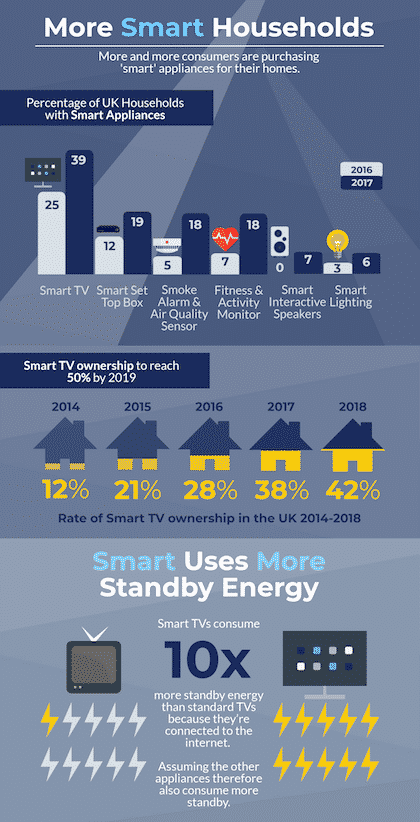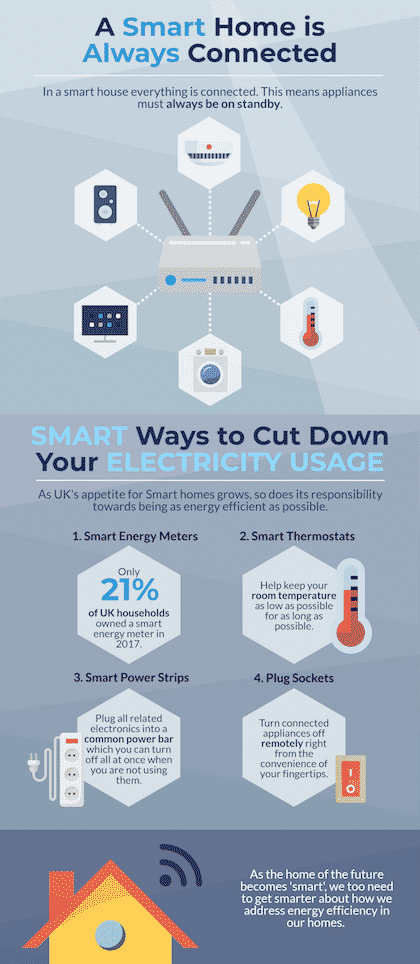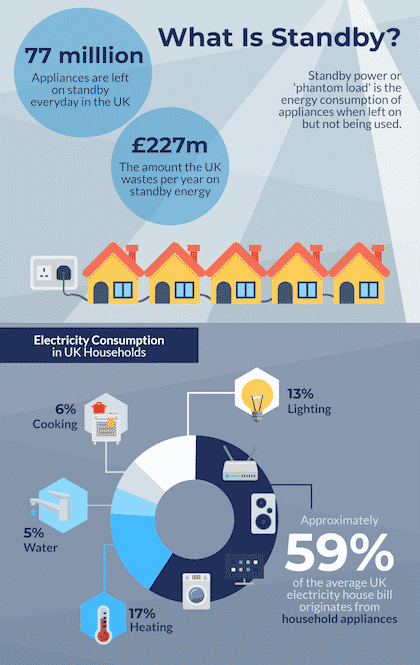Standby Energy Isn't Smart
Standby Energy Isn't Smart
- Last Updated: December 2, 2024
Guest Writer
- Last Updated: December 2, 2024



Standby energy, or phantom load, refers to the energy consumption of appliances left idle or on standby. It's a problem that continues to plague the UK despite the nation’s efforts to encourage energy efficiency. In addition to the more obvious leaving the lights on in an empty room or falling asleep with the TV on, other examples of similar “energy sins” include leaving a laptop plugged in even after it has finished charging and leaving a WiFi router plugged in overnight or while away at work.
A recent survey conducted by Schneider Electric found that approximately 77 million appliances are left on standby every day. Given that 59 percent of the average UK electricity bill is attributed to household appliances, this means that Britons are essentially throwing away a whopping £227 million every year in standby energy alone. Optimizing to limit standby energy translates into potential savings of as much as £100 annually per household.
Unfortunately, research has also indicated that in spite of the UK’s heightened awareness of its energy consumption, almost half of Briton admit they'd rather continue to commit “energy sins”—and overpay in utility bills—than deal with the added annoyance of modifying their habits at home. Nevertheless, the most seemingly insignificant changes can actually go a long way. For instance, according to the University of Cambridge, energy saved from not keeping your printer in standby mode could actually power both your LCD TV and your refrigerator at the same time. Even more strikingly, of the total energy consumed by a phone charger, only 5 percent of it is actually used to charge the phone. The other 95 percent is simply wasted on standby energy.
The Future Home Is Smart
To make matters worse, more and more households are replacing their low-tech appliances with smart devices. In 2014, for example, 12 percent of all the households in the UK owned a smart TV. Meanwhile, in 2018, the number has grown over threefold to 42 percent.

Image Credit: Greenmatch UK
Not only has the percentage of UK households owning a smart TV increased, so has the proportion of households owning other smart appliances. For instance, the proportion of UK households owning smart interactive speakers grew from 0 percent in 2016 to 7 percent in 2017. Considering that other smart appliances are also seeing similar spikes in consumption and household ownership, we can conclude two things with absolute certainty: IoT is changing not only the economics of every industry, including home appliances but also our lifestyles. The future appears to be “smart.” In fact, by 2021, it's predicted that an average of 8.7 devices will exist in a typical smart home.
Smart Devices Standing By
The downside of this upcoming trend is that smart appliances have been found to consume even more standby energy than the regular low-tech appliances. Research shows that a smart TV consumes 10 times more energy when left on standby than a standard TV would. As almost every second UK homeowner confessed to leaving their TVs on standby every night, this trend could result in dire ramifications down the road for the UK.
The reason for the significant difference in standby energy consumption between smart and "non-smart" devices has to do with all the extra features embedded in smart appliances. One power-hungry feature is the internet connection that smart appliances need more or less continuously. This means that the modem or router needs to be active or on standby for the entire time the smart appliances are in use or on standby.
Standby #Energy (or phantom load) is a little known but pervasive problem in many #SmartHomes. The Solution? Intelligent energy management applications.
Continuous Connectivity Is Draining
The continuous connectivity of wireless routers has consequences. Evidence suggests that it can cost the average UK household approximately £22 a year under the condition that it's never switched off. This is 20-25 percent of the total potential savings on standby energy consumption, making it one of the least economical devices in your home. Envisioning a future with close to nine devices in a typical smart home would make the router or modem an essential device to have.
Leveraging IoT for Energy Efficiency
The future is inevitably “smart” and calls for “smart” measures. For example, it's possible to reduce your standby energy consumption by using smart energy meters, smart thermostats, smart power strips, and smart sockets. Even though purchasing smart appliances is a rising trend, only 21 percent of UK households owned a smart energy meter in 2017. The benefit of these products is that they give insights into your energy usage and optimize energy flow based on your daily routines. Such devices don't solve the problem all at once, but it can help make the situation better.

Image Credit: Greenmatch UK
As more and more British households adopt smart appliances, and current devices get replaced with connected appliances, the importance of understanding their consequences (e.g. increases in standby energy) also increases. As a consequence, we should do our best to ensure that our homes remain as energy efficient as possible.
The article was written by Jonna van Lokven, Communications Assistant at GreenMatch.
The Most Comprehensive IoT Newsletter for Enterprises
Showcasing the highest-quality content, resources, news, and insights from the world of the Internet of Things. Subscribe to remain informed and up-to-date.
New Podcast Episode

What is Software-Defined Connectivity?
Related Articles






